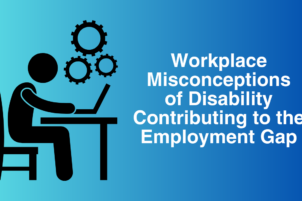We recognize the importance of authentic representation and how our interactions with others are often shaped by our experiences with popular culture, media, and the news. Unfortunately, this frequently leads to harmful narratives and stereotypes that can foster division and even fear of our community. Recent and far-reaching rhetoric has brought to light yet again some of the most popular misconceptions about autism. In line with Disability Belongs™’ mission to fight stigmas and advance opportunities, we want to ensure that harmful language and misunderstandings about disability, neurodivergence, and autism do not continue to spread unchecked in society.
Here are some common myths about autism, a type of neurodivergence and commonly considered a disability, and some of the facts you should know.
Myth: Autism always looks the same.
Fact: As the saying in the autistic community goes, “If you’ve met one autistic person, you’ve met one autistic person.” There are many ways that autism can present. Some autistic people like loud noises or intense stimulation, and others are overwhelmed by them. Some autistic people are social and extroverted, and others are more reserved. Not all autistic people have a special skill or interest – some do, many do not. One autistic person’s experience is just that, one experience.
Myth: Autistic people are less productive in the workplace.
Fact: Autistic people can be highly productive and successful in the workplace, even if accommodations or other supports are needed. Some research shows that autistic employees have even outperformed their neurotypical peers at many tasks.
Myth: Autistic people cannot communicate with others.
Fact: While communication might be more difficult for some autistic people, there are plenty of autistic people who have little difficulty communicating; some even do it every day for a living. Advocates like Greta Thunberg, faith leaders and authors like Lamar Hardwick, and entrepreneurs like Bill Gates are just some high-profile examples of autistic people who are highly effective communicators.
Myth: Every autistic person would like to be “cured.”
Fact: Many autistic people don’t view or understand their autism as a “disease”, “condition,” or even a disability. Many individuals view autism as part of their identities and who they are. We would prefer that society learn more about us, stop fearing us, and treat us with respect and consideration, just like anyone else.
Myth: It’s a problem that more people are being diagnosed as autistic today than in the past.
Fact: More people are being diagnosed as autistic today due to a greater awareness and understanding of autism by society at large. Being diagnosed as autistic is not an inherently negative thing. Sometimes a diagnosis or self-exploration leads to a better understanding of oneself and what supports or accommodations may be needed to thrive in different spaces.
Myth: Autistic people do not feel empathy or lack emotion entirely.
Fact: Autistic people, like neurotypical people, are fully capable of being empathetic towards others. Autistic individuals experience the same spectrum of emotions. Some autistic people even express their emotions more openly than their neurotypical peers do. Emotional expression and preference for emotional expression will vary from person to person.
Myth: Vaccines cause autism.
Fact: The scientific and medical consensus is that vaccines do not cause autism. Everyone can make health care decisions that are right for them. If one chooses to be vaccinated, there’s no reason to fear that autism will be a possible result.
Myth: Autistic people are expected to overperform – be so-called “supercrips.”
Fact: Autism is a spectrum and an overall part of human diversity, like other neurodivergent experiences. Some people, whether neurodivergent or neurotypical, can express exceptional talents, skills, or above-average adeptness in specific subjects or fields. However, this is not a unique trait to autism or because of autism. Some portrayals in media of “superhuman” talents and skills can cause people to view autistic individuals as caricatures who are always expected to live up to these portrayals, instead of being viewed as three-dimensional human beings.
Myth: Autistic people always struggle in social settings.
Fact: How everyone shows up in social settings is unique to their own personalities and experiences. Some autistic people miss social cues or become overwhelmed in social settings and others don’t.
Misinformation has real and lasting harmful effects on the communities that are targeted and can sometimes lead to greater barriers, discrimination, and violence. It is important to be continuously introspective about the ever-evolving landscape of cultural narratives, so we can better protect against isolation or misrepresentation of any identity or lived experience.
You can help stop the spread of misinformation by doing your own research from credible sources, evaluating your own biases, and sharing the facts about autism, rather than the myths, with others in your community. You can also learn more from organizations that are autistic- or disability-led. Educating yourself on the facts is how you can actively take action to combat misinformation and build bridges to a more inclusive society.
Combatting Misinformation is a five-part series from Disability Belongs™ to help correct harmful misinformation, narratives, and stereotypes around disability, neurodivergence, and mental health.








Well put, Ariel. Great list – I will pass it on. I was having a conversation with a non-autistic person recently about my own traits and concluded with, “You’ve met one autistic person, you’ve met one autistic person.” He completely misunderstood and replied, “But you aren’t like any other autistic person I know!”